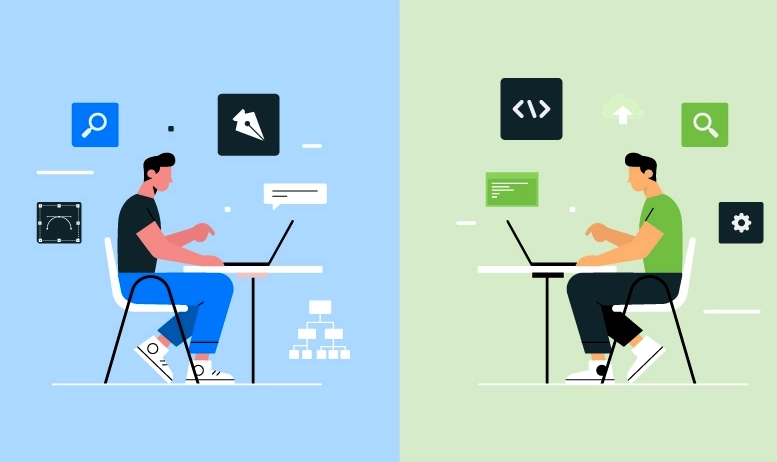
Website design and website development are some of the most used terms in digital marketing. Some use these terms interchangeably, not knowing that they are distinctively different from each other. That is why it is essential to understand the difference between these two and how they contribute distinctively yet collaboratively.
Website design adds to a website's visuals and user experience, while website development is all about the technical implementation of these designs. This article aims to clarify the difference between the two by highlighting their respective contributions. Later on, it will shed light on how they collaborate to contribute together.
Website design vs website development: key aspects
| Aspects | Website Design | Website Development |
|---|---|---|
| Main Goal | Creation of an aesthetically pleasing UI (user interface) | Implementation of interactivity and functionality |
| Major activities | UI/UX Designing Wireframing Prototyping | Coding Testing Debugging |
| Output | Mockups Style guides | Functional website Web application |
| Tools | Graphic Designing Software Solutions | Programming Languages (HTML, CSS, JavaScript) |
| Required Skills | Graphic Designing Sense UI/UX Principles | Programming Problem-Solving Technical Proficiency |
| SEO Importance | Consideration of basic SEO principles | Implementation of SEO techniques |
| Responsiveness | During design process | For various screen sizes and browsers |
| Visuals | Visually appealing layouts | Visual design implementation provided in the design phase |
| Content Management | Recommendations on content and layout | Implementations of content management systems (WordPress, Laravel, Shopify) |
The collaboration between design and development
Even though website design and development are two distinct disciplines in the creation of a website or web application, we can never ignore how powerfully they contribute together. It is not wrong to say that they complement each other. A design is a prerequisite for development and both are incomplete without each other. If you go for collaborative website design and development services in Christchurch, you will get the following benefits.

1- Merged user experience
Website design contributes to creative layouts while development guarantees technical smoothness of those layouts. Using them together lets website owners enjoy a smooth and frictionless user experience. In addition to capturing the attention of users, this unified user experience keeps them engaged through interactive navigation.
2- Brand consistency and cohesiveness
From branding elements to colors, typography, and components of the user interface, a combined design and development ensures consistency in the website. This consistency results in brand identity, building trust and credibility among the users.
3- SEO and Optimized Performance
For effective development of a website, the website owners need to go beyond design and aesthetics. By combining design and development, they prioritize SEO and performance, which would not be possible otherwise. Designers and developers collaborate closely to enhance website speed, code optimization, and responsiveness, resulting in better user experience and SEO.
4- Efficiency and time-saving
Combining website design and development activities gracefully organizes the workflow and eradicates any inefficient processes that come in the way of user experience. By sharing feedback and constantly making improvements in the initial stages, website owners can enjoy faster turnarounds.
5- Better functionality and innovation
When the website design and development teams sit together and work collaboratively, they bring out innovative features and functions that enhance user experience. From the integration of interactive elements, and optimization for mobile gadgets, to adding animations, design, and development always push boundaries together. This way, they help businesses differentiate their website from competitors.
Conclusion
If we conclude, website design and website development are harmonious aspects in the creation process of a website. Both focus on different features of the website to provide the best user experience. Once the website owners understand the difference between both, they can effectively collaborate with professionals and convey their message. Similarly, understanding how they contribute collectively will help them recognize why they cannot be ignored.

